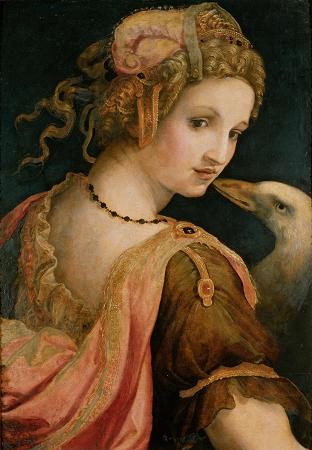Leda and Swan. Leda and the Swan is a story and subject in art from Greek mythology in which the god Zeus, in the form of a swan, seduces Leda. According to later Greek mythology, Leda bore Helen and Polydeuces, children of Zeus, while at the same time bearing Castor and Clytemnestra, children of her husband Tyndareus, the King of Sparta. In the W. B. Yeats version, it is subtly suggested that Clytemnestra, although being the daughter of Tyndareus, has somehow been traumatized by what the swan has done to her mother. According to many versions of the story, Zeus took the form of a swan and seduced Leda on the same night she slept with her husband King Tyndareus. In some versions, she laid two eggs from which the children hatched. In other versions, Helen is a daughter of Nemesis, the goddess who personified the disaster that awaited those suffering from the pride of Hubris. The subject was rarely seen in the large-scale sculpture of antiquity, although a representation of Leda in sculpture has been attributed in modern times to Timotheus; small-scale sculptures survive showing both reclining and standing poses, in cameos and engraved gems, rings, and terracotta oil lamps. Thanks to the literary renditions of Ovid and Fulgentius it was a well-known myth through the Middle Ages, but emerged more prominently as a classicizing theme, with erotic overtones, in the Italian Renaissance. The subject undoubtedly owed its sixteenth-century popularity to the paradox that it was considered more acceptable to depict a woman in the act of copulation with a swan than with a man. The earliest depictions show the pair love-making with some explicitness, more so than in any depictions of a human pair made by artists of high quality in the same period. The fate of the erotic album I Modi some years later shows why this was so. The theme remained a dangerous one in the Renaissance, as the fates of the three best known paintings on the subject demonstrate. The earliest depictions were all in the more private medium of the old master print, and mostly from Venice. They were often based on the extremely brief account in the Metamorphoses of Ovid, though Lorenzo de' Medici had both a Roman sarcophagus and an antique carved gem of the subject, both with reclining Ledas. The earliest known explicit Renaissance depiction is one of the many woodcut illustrations to Hypnerotomachia Poliphili, a book published in Venice in 1499. This shows Leda and the Swan making love with gusto, despite being on top of a triumphal car, being pulled along and surrounded by a considerable crowd. An engraving dating to 1503 at the latest, by Giovanni Battista Palumba, also shows the couple in coitus, but in deserted countryside. Another engraving, certainly from Venice and attributed by many to Giulio Campagnola, shows a love-making scene, but there Leda's attitude is highly ambiguous. Palumba made another engraving, perhaps in about 1512, presumably influenced by Leonardo's sketches for his earlier composition, showing Leda seated on the ground and playing with her children. There were also significant depictions in the smaller decorative arts, also private media. Benvenuto Cellini made a medallion, now in Vienna, early in his career, and Antonio Abondio one on the obverse of a medal celebrating a Roman courtesan. Leonardo da Vinci began making studies in 1504 for a painting, apparently never executed, of Leda seated on the ground with her children. In 1508 he painted a different composition of the subject, with a nude standing Leda cuddling the Swan, with the two sets of infant twins, and their huge broken egg-shells. The original of this is lost, probably deliberately destroyed, and was last recorded in the French royal Chateau de Fontainebleau in 1625 by Cassiano dal Pozzo. However it is known from many copies, of which the earliest are probably the Spiridon Leda, perhaps by a studio assistant and now in the Uffizi, and the one at Wilton House in England. Also lost, and probably deliberately destroyed, is Michelangelo's tempera painting of the pair making love, commissioned in 1529 by Alfonso d'Este for his palazzo in Ferrara, and taken to France for the royal collection in 1532; it was at Fontainebleau in 1536. Michelangelo's cartoon for the work, given to his assistant Antonio Mini, who used it for several copies for French patrons before his death in 1533, survived for over a century. This composition is known from many copies, including an ambitious engraving by Cornelis Bos, c. 1563; the marble sculpture by Bartolomeo Ammanati in the Bargello, Florence; two copies by the young Rubens on his Italian voyage, and the painting after Michelangelo, ca. 1530, in the National Gallery, London.
more...








